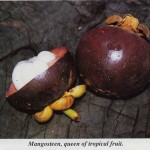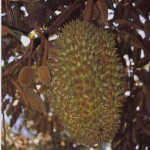Durian & Mangosteens
These two fruit, though quite unrelated, are regarded as the King and Queen of all tropical fruit. Few would fault the (purple) mangosteen (Garcinia mangostana), except that the rind leaves an indelible stain. Not so the durian (Durio zibethinus). Lovers of the fruit have mortgaged their possessions to gorge themselves. Others loathe the durian. Doctor Paludanus commented that “…it seems at first to smell like rotten onions…”. Linschott (1599) in reporting  his travels wrote: “It is of such an excellent taste that it surpasses in flavour all the other fruits of the world…” Professor Alfred Wallace, a botanist specialising in the study of tropical fruit before the days of the steam ship, asserted that “the taste of durian is worth the travel to the Far East”.
his travels wrote: “It is of such an excellent taste that it surpasses in flavour all the other fruits of the world…” Professor Alfred Wallace, a botanist specialising in the study of tropical fruit before the days of the steam ship, asserted that “the taste of durian is worth the travel to the Far East”.
Both mangosteen and durian are native to South East Asia and require a year round, warm, very humid, equatorial climate. The durian tree is very large. Picking the fruit is not required, as they fall when ripe. This is quite dangerous; the fruit is covered with hard spines and weighs several kilograms. Overripe durians split along lines of natural weakness which are faintly visible among the spines. To open a durian, insert a stout knife into such a line. Durians have about five segments, each containing several seeds and these are surrounded by a custard-like aril. Freshly fallen fruit are less pungent and may taste best.
Without refrigeration the fruit has a shelf life of only 2 -5 days. Fermented durian, wrapped in palm leaves, remain palatable for up to a year. The preparation is called “tempoya” in Indonesia and is a popular side dish. They may also be used mixed with rice and sugar to make “lempog”, or minced with salt, onions and vinegar, for “boder”. Durian seeds may be roasted in hot ashes, or cut into slices and fried in spiced coconut oil. They are eaten with rice, or mixed with sugar to make a sweetmeat. Half-ripe fruit are used in soups. The durian is not only a meal to the lover, but has in fact the requisite food values. Though the fruit has much waste, it is very filling and high in proteins, minerals and fats.
To choose a durian, pick a fruit which is comparatively light and who’s stem appear big and solid. When shaking a good durian, the seed should move. Maturity is indicated when the middle of the fruit exudes a strong, but not sour smell. Finally, an inserted knife should come out sticky -this is the best indication that the fruit is ripe. Cut fruit perishes fairly rapidly. Avoid fruit with holes: worms may have prior claims.
The durian provides a meal without preparation, and for some, a rich dessert too. The fruit is suitable for the preparation of milk based foods, such as milk shakes, ice cream and custards.
Both durian and mangosteen are still rare outside South East Asia, and they will remain expensive when available. The ripe mangosteen is dark red and tastes best if harvested before turning purple or blue-black. It does not ripen post-harvest. Unlike many other tropical fruit, which have a somewhat musky flavour (a liking for which is acquired), the mangosteen appeals to almost all, without a “learning” period. The mangosteen would be a popular choice as the finest of all fruit. The fruit is the size of a mandarin. The outer skin is up to 8mm thick and rich in tannic acid, which makes the fruit insect resistant. To open the fruit, cut through the skin only, and lightly pull and twist the fruit apart. Experienced mangosteen eaters use their thumb to pry out the dried flower parts (sessile stigma) and then break the fruit open.
About a third of the fruit is edible and this part consists of 4 to 8 white to pinkish juicy segments. The precise number is indicated by the remnant flower parts on the front of the shell. A greater number of segments reduces the chance of seeds. Seeds can be boiled or roasted and eaten. The fruit’s taste is delicate, sweet-acid, and the pulp seems to melt in the mouth.
The fruit will keep for a few days without refrigeration. Storage at 10ºC is ideal and extends shelf life to about 20 days. Refrigeration causes cold damage. To minimise this, wrap fruit in newspaper and store it in the upper part of a refrigerator, but away from cooling coils. Freezing the fruit whole is also satisfactory. Purple mangosteen trees have only female flowers and pollen fertilisation is not required. The fruit contains up to three “seeds”. These  are composed of reproductive female flesh, which could still germinate when cut apart. Trees are very slow growing and rarely fruit before they are ten years old. Additionally, the cultural requirements are stringent, further reducing the supply of fruit.
are composed of reproductive female flesh, which could still germinate when cut apart. Trees are very slow growing and rarely fruit before they are ten years old. Additionally, the cultural requirements are stringent, further reducing the supply of fruit.
The yellow mangosteens are much easier trees to grow and bring to fruiting than the (purple) mangosteen. There are several species of yellow mangosteen, including the mundu (G. dulcis), the kochin goroka (G. xanthochymus) and the asam gelugur (G. atroviridis).
They are frequently extremely sour fruit, and perhaps the ultimate test for the miracle fruit. When cooked with plenty of sugar to counter the acidity, these fruit produce an excellent pie. Other Garcinia species, have less to recommend them as a fruit tree; the imbe (G. livingstonei) is small fruited, has a large seed and a little sour flesh.
Recipes
| 5 durians 500ml sugar |
Scoop the durian pulp from the rind. Heat pulp in a saucepan and stir. While stirring, pick out the seeds, then add the sugar and mix well. Continue stirring until the mixture coagulates. Remove from heat and wrap in some “breathing” wrapping -traditionally palm leaves. These cakes will keep for up to one year. From Malaysia |
| 750ml dried green peas 2ml salt 750ml water 200ml brown sugar durian pulp from around 6 seeds 130ml sago |
Soak peas in salted water overnight. Boil peas in water until they become soft, add more water if required. Boil brown sugar in 250ml water, add to the peas. When peas reach boiling point again, add the durian pulp and mix well. Add sago and boil for a few minutes. From Malaysia |
| 150ml butter 200sugar 4 eggs, separated 120ml durian pulp 300ml SR flour |
Beat butter and sugar till light. Add egg yolks, beating well after adding each yolk. Beat in durian pulp. Beat the egg whites to a stiff froth, then fold into the mix. Gently fold in the flour. Bake in a greased tin for 60 minutes at 180ºC. |
| 1 sweet crumb crust II 40ml gelatine 60ml water 4-6 sliced yellow mangosteen 500g Philadelphia cream cheese 1 can cold condensed milk 300ml thick cream |
Stir gelatine in water, heat gently in microwave oven on low, or on a stove until dissolved. Briefly blend mangosteen slices and set aside. Beat cream cheese, add condensed milk, continue beating for 2 minutes. Add cream and beat again until the bulk has doubled. Add dissolved gelatine to the mixture, pour into the prepared crumb crust and refrigerate. |
